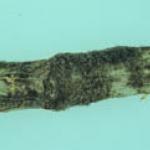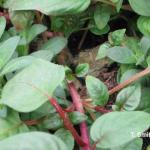Botrytis Blight of Greenhouse Crops
Botrytis blight (“moho gris” or “pudrición gris” in Spanish) is one of the most common fungal diseases of greenhouse crops. The disease is often referred to as gray mold because it produces abundant fuzzy gray spores on the surfaces of infected tissues. Botrytis blight is most often caused by Botrytis cinerea, but other species may also be problematic. A wide variety of plants including ornamentals, vegetables, and herbs are susceptible. A sound IPM program including is necessary to control this disease.
Signs and Symptoms
Depending on the host and environmental conditions, Botrytis can cause leaf and flower blight, fruit rot, cankers, damping off, and root rot. Plants may be attacked at any stage but tender new growth, freshly injured tissues, and aging or senescent tissues are preferred. Leaf lesions may begin as brown, water-soaked areas. Spores may be whitish in appearance but turn gray as they mature. The fuzzy spore masses may be visible to the naked eye or observed with a hand lens. Copious spores are produced on lesions as well as on plant debris left on benches, the greenhouse floor, and cull piles.
Disease Cycle
Like other fungi, Botrytis has a specific range of temperature and relative humidity that is necessary for spore germination, infection, and disease development. Germination of spores and infection of the host is dependent on a film of moisture for 8 to 12 hours, relative humidity 85% or greater, and temperatures 55 - 75°F. Colonization of plant tissue takes place at a wide range of temperatures, but 60-75°F is optimum. Botrytis blight is more prevalent in the spring and fall months. Spores are easily disseminated by air currents and splashing water. The fungus may also produce chlamydospores and/or microsclerotia, both of which can survive in soil for extended periods of time. Given the common occurrence of Botrytis in greenhouses and the relative ease with which it spreads, greenhouse managers must avoid conditions that are conducive to disease development.
Cultural Management
An integrated program including good sanitation practices, monitoring, environmental control, and fungicides is required for the successful management of Botrytis blight. Control weeds and remove plant debris between crop cycles and during production. Remove plant debris from the greenhouse completely; do not place it in garbage cans. Space plants properly to allow for good air circulation, which reduces both leaf wetness duration and the relative humidity within the canopy. Avoid overfertilization, which leads to overproduction of succulent tissues. Manage insect pests, which may carry spores between plants and cause injuries that enable fungal infection. Environmental regulation (temperature, relative humidity, leaf wetness duration) is critical.
Reduce humidity. Reduction of humidity by heating and ventilating is relatively inexpensive compared to the loss of revenue that can result from Botrytis blight and other plant diseases. Warm air holds considerably more moisture than cool air. In the evening, as warm air becomes cooler, the relative humidity (RH) rises until water vapor begins to form a film of moisture on surfaces (dew formation). This film of moisture is essential for Botrytis (and other fungal pathogens) to germinate and cause infection. To prevent excessive humidity and dew formation, turn on the heat and open the vents. The warm humid air is ventilated to the outside as the cooler outside air is drawn into the greenhouse. Even if the incoming air is saturated, the RH will drop significantly as the air warms. This air exchange should only take 5 or 10 minutes. The energy necessary to run fans and to provide heat is not significant. Under some conditions, this cycle may have to be repeated several times during the evening. The process can be simplified by installing timing devices. For more details, see the fact sheet Reducing Humidity in the Greenhouse
Moving air, even in a closed greenhouse, helps to reduce moisture on plant surfaces. Horizontal air-flow produces more uniform temperatures and reduces the probability that cool spots in the greenhouse will develop a condensation problem. For more details, see the fact sheet Horizontal air-flow. Humidity can also be reduced by watering in the morning when it is cool so that rising temperatures absorb moisture.
Chemical Management
Many conventional and organic fungicides are available for Botrytis control in greenhouses. See the New England Greenhouse Floriculture Guide for a full listing.
Greenhouse populations of Botrytis rapidly develop fungicide resistance with repeated applications of fungicides with the same mode of action (FRAC Group). Resistance to thiophanate-methyl (Cleary's 3336) and iprodione (26 GT) has become common in Botrytis populations; therefore, these fungicides are no longer recommended. Group 11 fungicides (strobilurins) are very susceptible to fungicide resistance development and should not be applied consecutively or alternated with each other. Always alternate fungicide applications among materials with different modes of action to prevent resistance developement. Another strategy is to use combination products or tank mix protectant fungicides like mancozeb, copper, or chlorothalonil with systemic fungicides.



